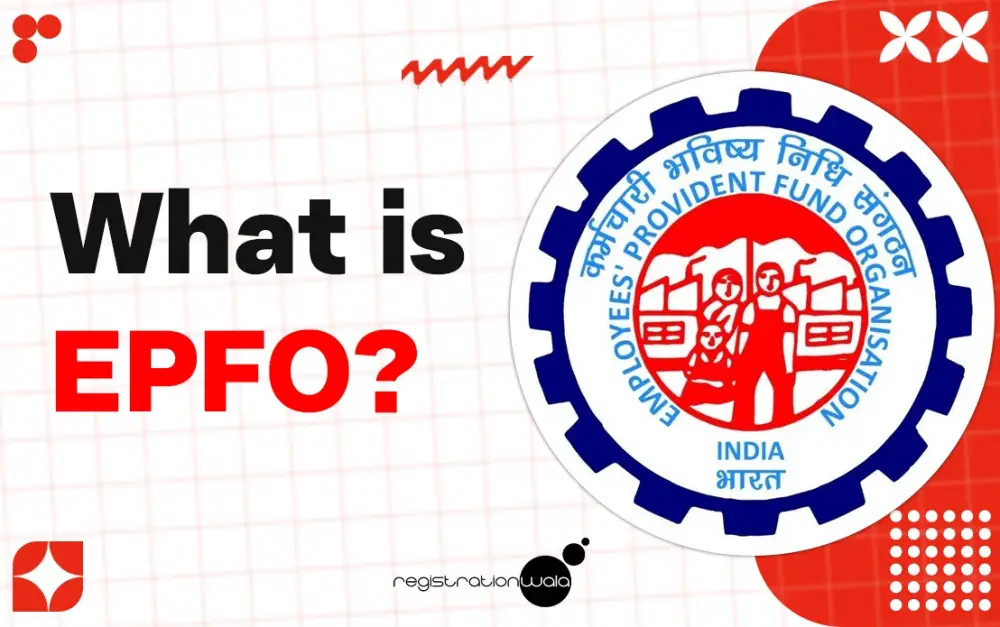What is EPFO? - Know Its Objective, Scheme and Eligibility
- May 13, 2024
- Registrationwala

- Home
- /
- Knowledge Base
- /
- News & other businesses
- /
- Blog
- /
- What is EPFO? - Know Its Objective, Scheme and Eligibility
What is EPFO? - Know Its Objective, Scheme and Eligibility
EPFO is a non-constitutional body which encourages the employees to save funds for their retired life. If you’re wondering what is the full form of EPFO, it is Employees' Provident Fund Organization.
In this article, we will discuss what is EPFO, from its objectives to its EPFO scheme.
What does EPFO do?
The Employee Provident Fund Organization (EPFO) was launched in 1951 and is governed by the Ministry of Labour and Employment, Government of India. EPFO came into existence after the Employees Provident Fund ordinance was passed in 1951.
There are various schemes offered by EPFO, namely Employees' Provident Funds Scheme 1952 (EPF), Employees' Pension Scheme 1995 (EPS) and Employees' Deposit Linked Insurance Scheme 1976 (EDLI). EPFO helps its apex decision-making body Central Board of Trustees (EPF) in the administration of all these schemes for the registered establishments in India and includes the employees of all such establishments and international workers who are covered.
For the purpose of implementing Bilateral Social Security Agreements with other nations, EPFO is the nodal agency. In addition to this, in terms of the beneficiary base and the quantum of financial transactions undertaken, EPFO is the largest social security organization in India. Several measures, including digital initiatives, have been taken by EPFO to simplify the operation of EPF accounts for employers as well as employees in the recent past.
What are the Objectives of EPFO?
The EPFO has the following objectives:
- One of EPFO’s primary goal is to ensure that each employee owns only one EPF account
- It makes sure that the compliance is made as simple as possible for all the employees and employers
- Another objective of EPFO is to ensure prompt pension payment and settlement of claims.
- It assures the dependability of internet services for checking EPFO details like umang app PF balance check, epfo online claim, provident fund statement download, and so on easily.
- It ensures that all member accounts are easily available online, and that the individuals can apply for PF withdrawal online easily.
- It encourages and promotes voluntary compliances.
- It fixes EPF interest rates every FY so that the employees can benefit from them.
What is EPFO Scheme?
Employee Provident Fund, popularly known as EPFO Scheme or PF, is a retirement savings scheme which is available to all the individuals who are considered as salaried employees. This scheme is backed by the government and pays a fixed interest rate to all employees. The current EPF rate for 2024 is fixed at 8.25%.
Must Read: How to Pay ESIC Challan Online?
It is mandatory to open an EPF account for the employees earning a salary of Rs. 15,000 and above. However, individuals at any income level can voluntarily opt for EPFO scheme. An employee is not eligible for contribution to EPF account once they stop working. Any contribution under EPF by the member has to match with the employer’s share of contribution, according to EPFO.
What is the Eligibility for joining EPFO Scheme?
To join EPFO scheme, the following eligibility requirements must be met:
- The EPFO is open for employees working in the Public and Private Sectors. This means that all the employees can apply for EPFO scheme.
- Any organization with at least 20 employees is liable to extend the EPFO benefits to its employees.
- Once the employees become active members of the EPFO scheme, they are eligible to avail several benefits of EPFO such as insurance benefits and pension benefits.
Conclusion
EPFO helps the employees to save funds which can be used by them to lead a comfortable life post retirement. It aims to meet the evolving needs of a comprehensive social security in a manner which is transparent, contactless and paperless. EPFO promises the ease of living for members and pensioners, and also ease of doing business for the employers by taking advantage of the Government’s technology platforms for reaching out to millions of Indians. If you liked this blog post, check out the rest of our blog posts!
- 1089 views
